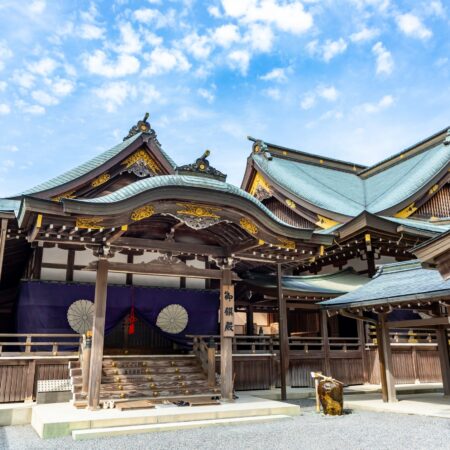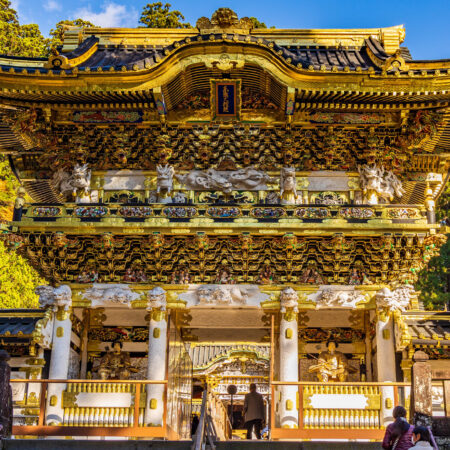Hello everyone, have you ever visited Izumo Taisha? Located in Shimane Prefecture, in the land known as the realm of the gods, Izumo Taisha is a shrine with a rich history, dedicated to Okuninushi-no-Okami, the deity famous for developing and establishing the nation of Japan. Izumo Taisha, along with Ise Grand Shrine, holds a significant place in Japanese history. Did you know that this shrine was built as a result of Okuninushi-no-Okami transferring his governance of the land to Amaterasu Omikami, the sun goddess and a central figure in Japanese mythology? Additionally, did you know that there are countless rabbit statues within Izumo Taisha? This time, we will introduce the lesser-known history, highlights, and trivia of Izumo Taisha.
The History of Izumo Taisha
When discussing the history of Izumo Taisha, the presence of Okuninushi-no-Okami is indispensable. Let’s explore who Okuninushi-no-Okami was and his relationship with Izumo Taisha.
The Relationship Between Okuninushi-no-Okami and Izumo Taisha
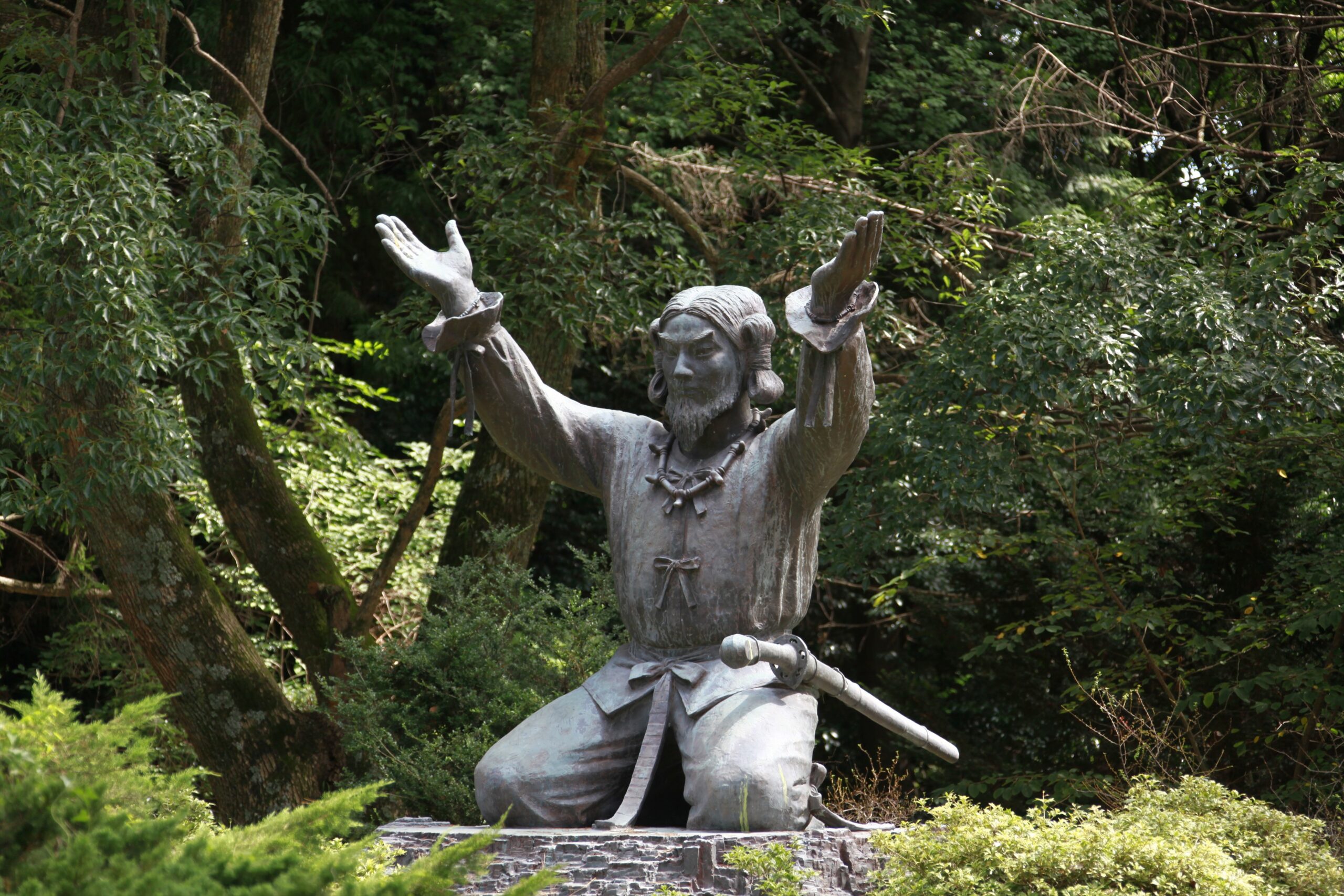
Okuninushi-no-Okami, considered a symbol of the rich nature and culture of the Izumo region, was born as the youngest of many siblings. He is also known as "Daikoku-sama," and is often depicted with a large sack and a mallet, standing on rice bales, symbolizing his nature as the god of abundance and prosperity. According to legend, he married Suseribime, the daughter of Susanoo-no-Mikoto, and worked with Sukunabikona to build the nation. They taught the people about magic and medicine, ultimately establishing peace and prosperity in the land known as Ashihara no Nakatsukuni. Additionally, by enshrining Omononushi-no-Kami, they ensured the security and prosperity of the region.
One of the most significant events in the history of Okuninushi-no-Okami was the request for the transfer of the land from Amaterasu Omikami. When messengers from Takamagahara (the High Plain of Heaven) delivered this request, Okuninushi engaged in negotiations that included both dialogue and military force. Ultimately, he accepted the role of the ruler of the unseen world. One of the conditions of this land transfer was the construction of a grand palace, "like the great nest of the heavens," which became Izumo Taisha. This event marked the beginning of the construction of the current Izumo Taisha.
Izumo Taisha is also famous for its association with matchmaking, a connection that also stems from the legends of Okuninushi-no-Okami. As he worked to prosper the Izumo kingdom, he married many goddesses and fathered numerous children. This story of Okuninushi's popularity among women laid the foundation for his reputation as the god of matchmaking. The construction of Izumo Taisha was thus influenced by these mythological and historical events, serving as a testament to the power and influence of Okuninushi-no-Okami.
(Image Citation: ニュースイッチ)
The History of Construction
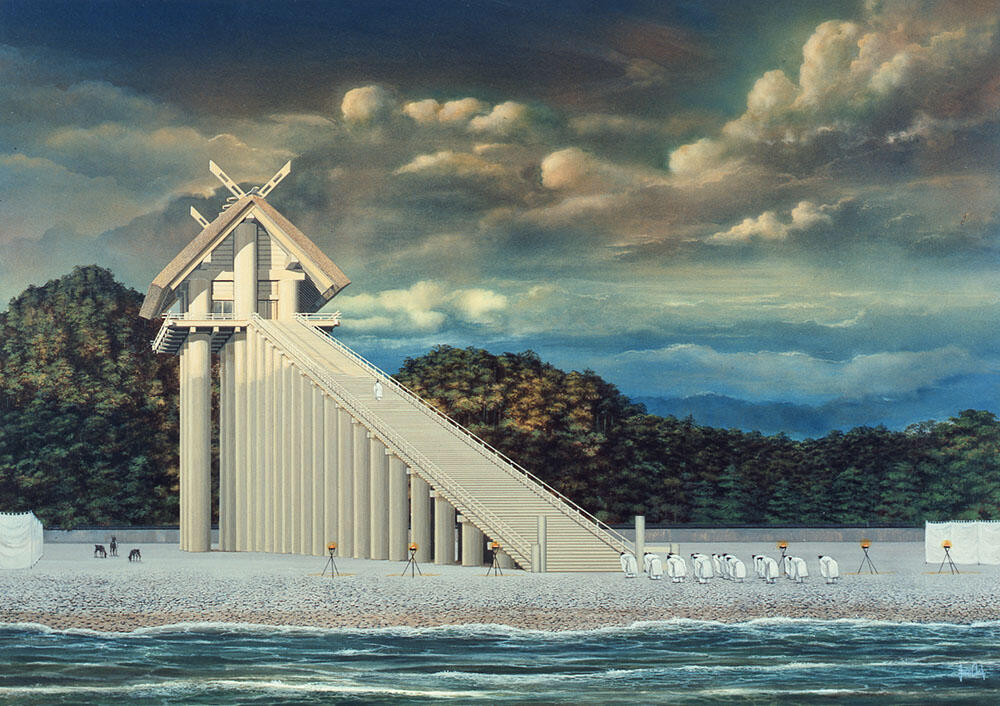
Izumo Taisha's historical architecture is also associated with fascinating legends. The current Main Sanctuary (Gohon-den), a National Treasure, was constructed in 1744 and stands about 24 meters tall. However, according to shrine tradition, in ancient times, the height of the sanctuary was said to be four times its current height, approximately 96 meters. This staggering height would have allowed the chigi (ornamental crossbeams) of the Main Sanctuary to be visible from near the summit of Mount Yakumo (about 100 meters tall). Additionally, during the Heian period, the sanctuary was believed to be around 48 meters tall, showcasing the pinnacle of the architectural techniques of that era.
In 2000, a significant discovery was made on the south side of the current Main Sanctuary: the remains of a massive pillar believed to date back to the early Kamakura period. This find provided substantial evidence of the once colossal shrine structure and prompted a reevaluation of previous understandings of Izumo Taisha’s history and architecture, shedding new light on the study of ancient Japanese history.
(Image Citation: 季刊大林)
The Highlights of Izumo Taisha
Let's Continue with the Highlights of Izumo Taisha. There are many attractions, so if you plan to visit Izumo Taisha, this is a must-read!
Gohon-den (Main Sanctuary)
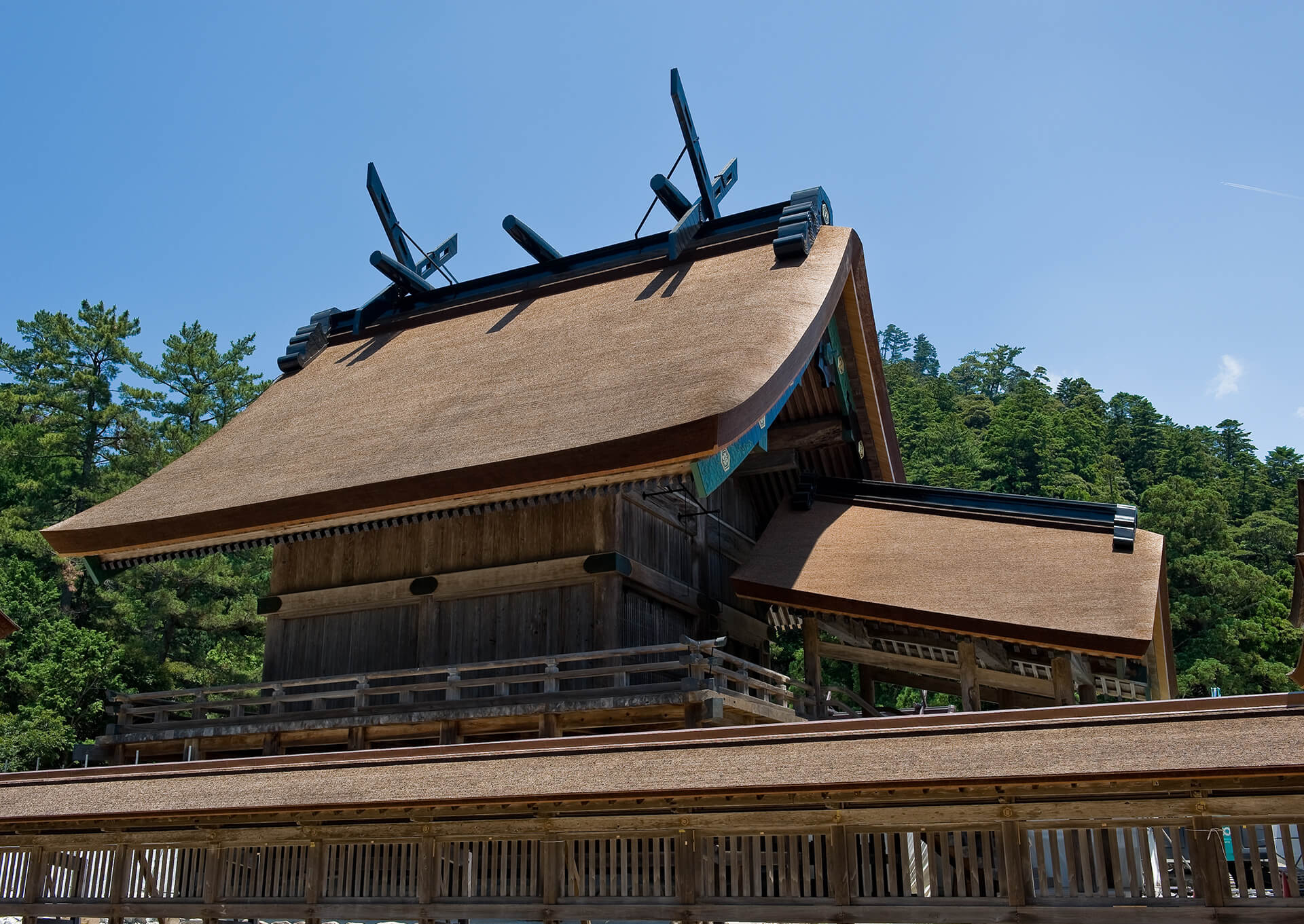
The Gohon-den (Main Sanctuary) is considered the most sacred place at Izumo Taisha and is one of the must-see highlights for visitors. The current Gohon-den, built in 1744, is designed in the "Taisha-zukuri" style, the oldest architectural style in Japan. Due to its historical significance and beauty, it has been designated as a National Treasure. The Taisha-zukuri style reflects the characteristics of ancient Japanese architecture, featuring unique roof shapes and pillar arrangements, preserving traditional aesthetics. The Gohon-den is renowned for its intricate structure and beautiful decorations, exemplifying how Japanese architectural techniques have created sacred spaces.
However, as the most sacred area, the Gohon-den is not accessible to the general public. Worshippers conduct their prayers in front of the "Hasshō-mon" gate, the gateway to the Gohon-den. The Hasshō-mon itself is captivating with its solid construction and traditional beauty. Passing through this gate, worshippers take a step into the sacred space, and their prayers towards the Gohon-den are conducted with deep respect and tranquility. The path leading from the Hasshō-mon to the Gohon-den provides visitors with a time for reflection and inner peace. Through this journey, visitors can closely feel the solemn atmosphere of Izumo Taisha and the sacred power residing there.
(Image Citation: 出雲大社公式HP)
Seidamari no Otorii (Grand Torii Gate of Seidamari)
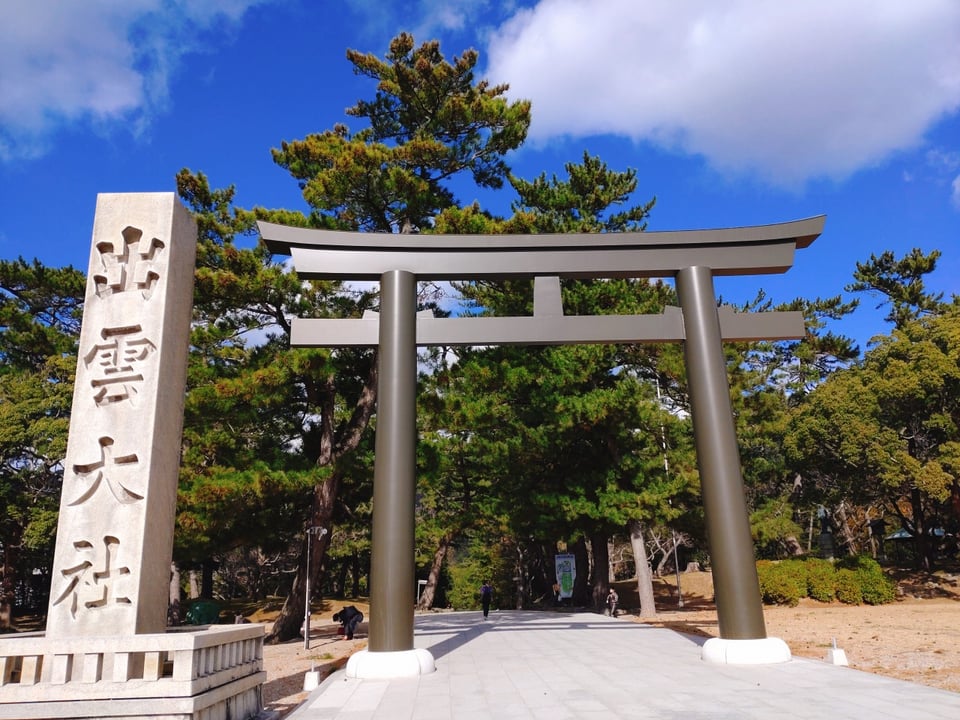
The "Seidamari no Otorii," symbolizing the entrance to Izumo Taisha, is a grand gate that captivates visitors with its presence and historical significance. This imposing metal structure stands about 8.8 meters tall and 12 meters wide, leaving a deep impression on those who visit.
The name "Seidamari" originates from the large theater once located in this area, where many people gathered, creating a bustling atmosphere. The term "seidamari" means "a place where people gather in force," reflecting the cultural history of the area where people met, interacted, and enjoyed festivals and plays.
The current torii, rebuilt in 2018, replaced the previous wooden structure with a metal one, showcasing how Izumo Taisha has evolved with the times. This new torii, blending modern technology with tradition, serves as a symbol of a new beginning for visitors to Izumo Taisha, marking the shrine's continuous progression through history.
(Image Citation: 奈良・大和八木ゲストハウスはじまり)
Kaguraden (Kagura Hall)
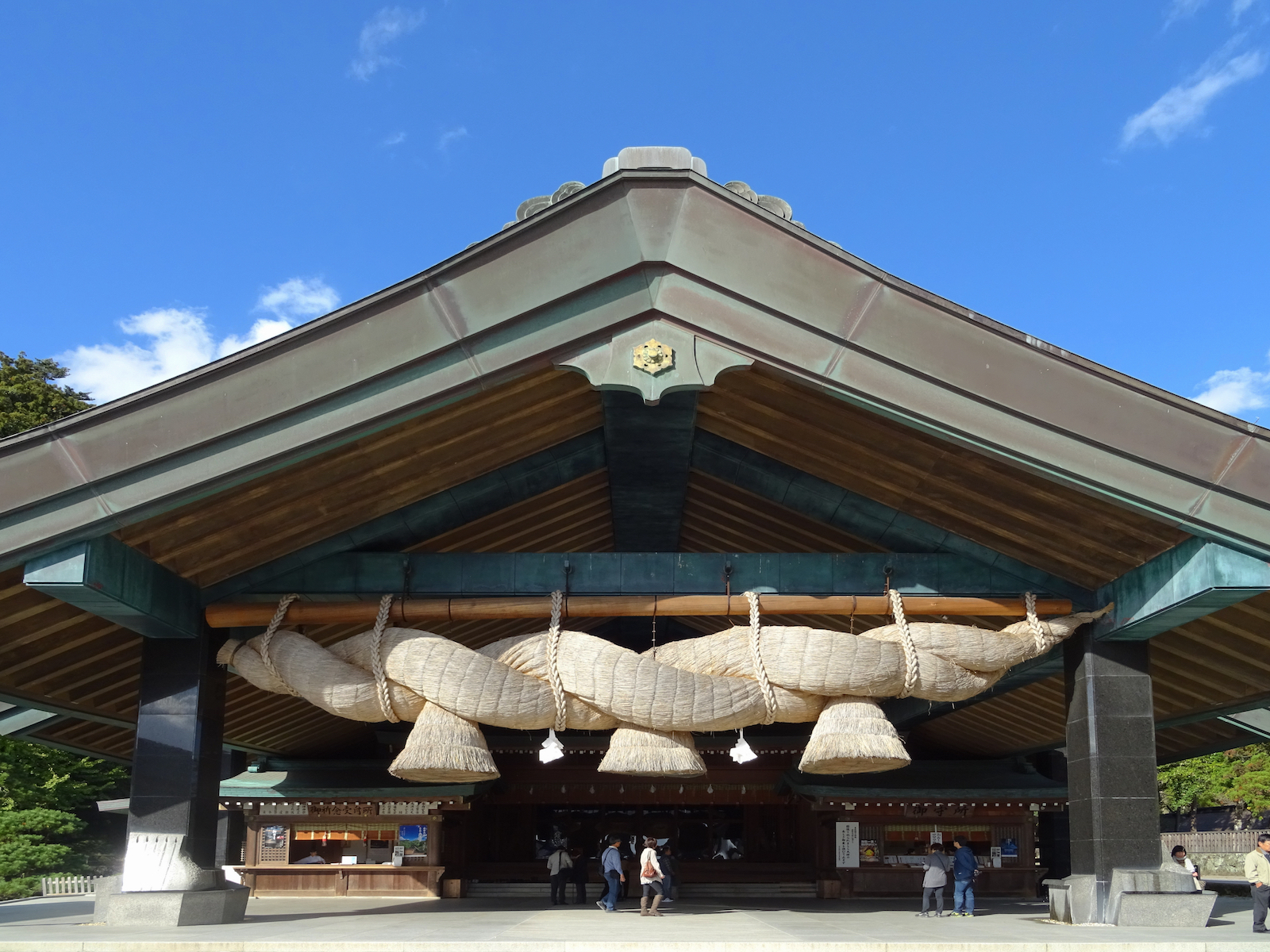
The Kagura Hall (Kaguraden) of Izumo Taisha is one of the must-see attractions for visitors, with its historical background and unique architectural beauty. Originally used as the great hall of the Senge Kokuzo family (the family of the chief priest of Izumo Taisha) and called Fuchokan, this building has functioned as a shrine since the establishment of Izumo Taishakyo in the Meiji period. It hosts various festivals, events, prayers, and weddings.
Of particular note is the current Kagura Hall, which was expanded and rebuilt in 1981 to commemorate the 100th anniversary of Izumo Taishakyo's establishment. The great hall boasts a size of 270 tatami mats, and its grandeur is awe-inspiring to visitors. The hall features a unique blend of traditional Japanese architecture and modern elements, such as the stained glass used in the front gable decoration. In front of the Kagura Hall hangs a massive shimenawa (sacred rope) that is approximately 13 meters long and weighs 5.2 tons. The sheer presence of this giant shimenawa fascinates visitors, and its periodic replacement ceremony is also a notable event.
Additionally, in the front yard of the Kagura Hall stands a 47-meter-high flagpole, with a national flag measuring 75 tatami mats (8.7 meters by 13.6 meters) raised on it, creating an impressive spectacle. Behind the Kagura Hall, there are guardian shrines dedicated to the ancestral deities of the Senge Kokuzo family and the Tenmangu Shrine. To the south of the flagpole are the Harae-no-Yashiro and the Kotohira Shrine. These shrines are also worth visiting when exploring the Kagura Hall area.
(Image Citation: ニッポン旅マガジン)
Haiden (Worship Hall)
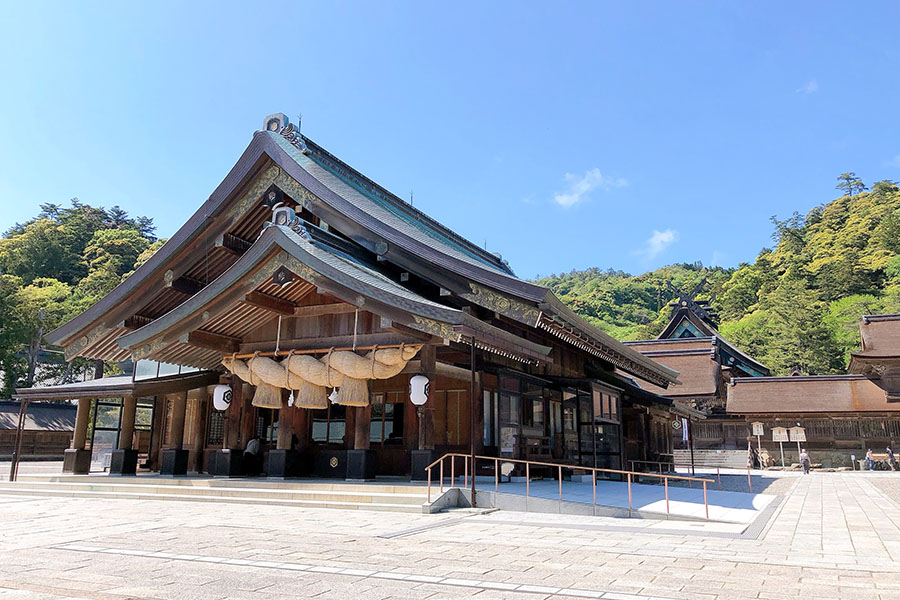
The Worship Hall (Haiden) of Izumo Taisha is a prominent structure standing in the vast precincts of the shrine. The current building, constructed in 1959, boasts a height of approximately 13 meters. It is considered one of the largest wooden structures built in post-war Japan, attracting many visitors with its grandeur and beauty. The construction of the new Haiden was part of a restoration project necessitated by a fire in May 1953, which destroyed the old Haiden, Sankaden, and Chonoya. The completion of the new Haiden was a major project, costing 110 million yen, funded by donations from worshippers nationwide, and overseen by Prince Nobuhito Takamatsu.
The Haiden is a symbol of the high level of wooden architecture in Japan during the post-war reconstruction period. The unique method of worship at Izumo Taisha involves two bows, four claps, and one bow (ni-rei, yon-kashiwade, ichi-rei). This distinctive practice is a traditional way of worship at Izumo Taisha, symbolizing its uniqueness and sanctity. For worshippers, this special method of worship offers a precious experience to deeply feel the sacred atmosphere of the shrine.
The Haiden is also the central location for important ceremonies and events at Izumo Taisha. Through these sacred rituals and festivals, the bond between the deities of Izumo Taisha and the worshippers is strengthened, bringing spiritual peace and healing to many people.
(Image Citation: しまね観光ナビ)
Harae-no-Yashiro
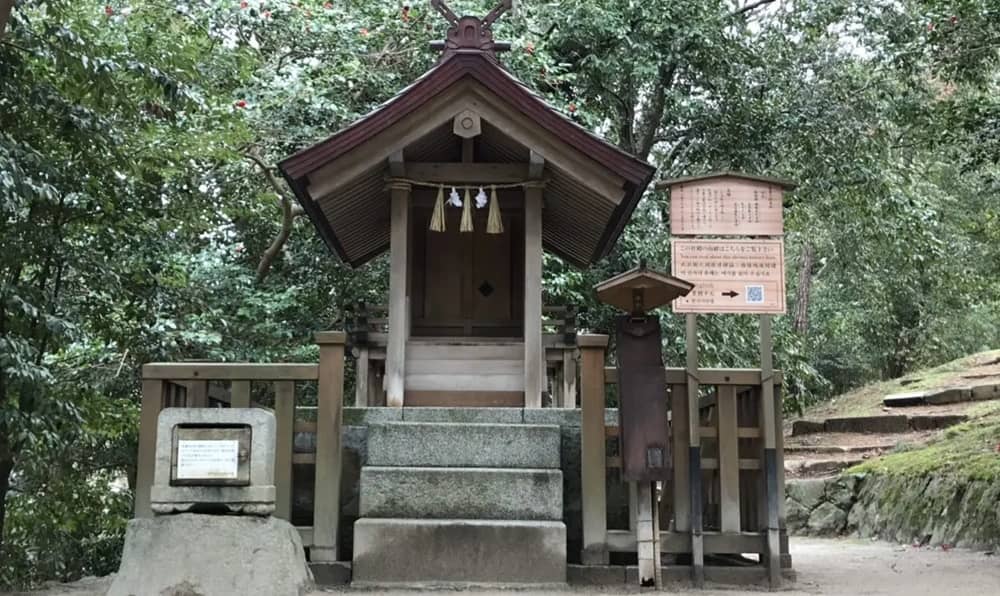
As you step into the grounds of Izumo Taisha, you are greeted by a solemn atmosphere. Passing through the grand torii gate of Seidamari and proceeding along the approach path, you will find "Harae-no-Yashiro" on your right. This is one of the important shrines to visit before worshipping at Izumo Taisha. Harae-no-Yashiro enshrines the four purification deities (Haraedo no Kami), who cleanse and purify the mind and body.
The role of Harae-no-Yashiro is to allow worshippers to purify themselves before approaching the main shrine, ensuring they can offer their prayers in a pure state. This small shrine holds an essential position in the flow of worship within the grounds of Izumo Taisha, and its serene and tranquil atmosphere provides visitors with a sense of peace.
By visiting Harae-no-Yashiro, you can cleanse away the troubles and worries accumulated in daily life, enabling you to begin your dialogue with the deities with a renewed spirit. Positioned at the start of the approach path, this shrine can be considered the first step in deepening your worship experience at Izumo Taisha.
(Image Citation: 出雲大社が好きになる!)
Jukusha
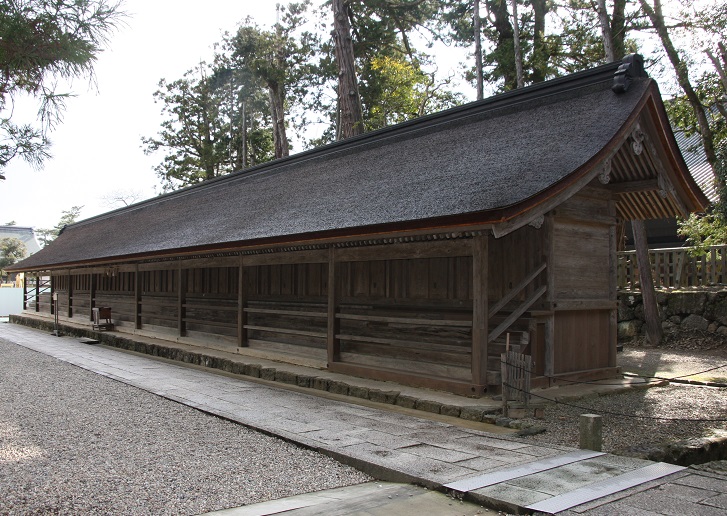
Within the grounds of Izumo Taisha, there are unique elongated buildings called "Jukusha" (十九社), situated to the east and west of the main sanctuary. These buildings, exclusive to Izumo Taisha, carry the rich history and tradition of the shrine in their name.
One particularly interesting custom is observed in the Izumo region every year in the old lunar calendar month of October. Typically referred to as "Kannazuki" (the month without gods) across Japan, this period is believed to be when all the deities leave their shrines to gather in Izumo, leaving other areas devoid of gods. However, in Izumo, this month is called "Kamiarizuki" (the month with gods), celebrating the gathering of deities.
The Jukusha at Izumo Taisha serve as accommodations for these visiting deities during Kamiarizuki. Because of this unique tradition, many worshippers visit Izumo Taisha in October, forming long lines at the Jukusha. This period holds great significance, as worshippers can pray to all the deities gathered from across the country at once, making the Jukusha especially important during Kamiarizuki.
(Image Catation: 出雲大社の歩き方)
Trivia about Izumo Taisha
Let's Wrap Up with Some Trivia About Izumo Taisha. You might be surprised by how many things you didn't know!
Did You Know That Izumo Taisha Has Only Recently Been Called by This Name?

Izumo Taisha was originally known as "Kizuki Taisha" (or Kizuki no Ooyashiro). This name is believed to have originated from the region where the shrine is located and from ancient myths. However, in 1871 (Meiji 4), as part of the Meiji government's reforms of the shrine system, the shrine's name was changed to "Izumo Taisha." This renaming occurred within the context of the introduction of the shrine rank system and the nationwide organization and systematization of shrines that accompanied the Meiji Restoration.
Under the modern shrine rank system introduced in the early Meiji era, shrines were categorized into ranks such as "Kanpei Taisha" (Imperial Shrine of the highest rank) and "Kanpei Chusha" (Imperial Shrine of the middle rank) based on their importance and historical significance. Kizuki Taisha was designated as one of the Kanpei Taisha due to its significance, and its name was changed to "Izumo Taisha" at this time. This renaming aimed to enhance the shrine's national recognition and clarify its historical and religious importance.
Today, the official name of Izumo Taisha is "Izumo Ooyashiro," as confirmed by the shrine's official website. This name change reflects the shrine's redefined identity and the modernization policies of the Meiji government, which included reforms of the Shinto shrine system. Thus, the renaming of Izumo Taisha is closely related to changes in policies toward Shinto and shrines in Japan.
(Image Citation: カラデル)
Numerous Rabbit Statues
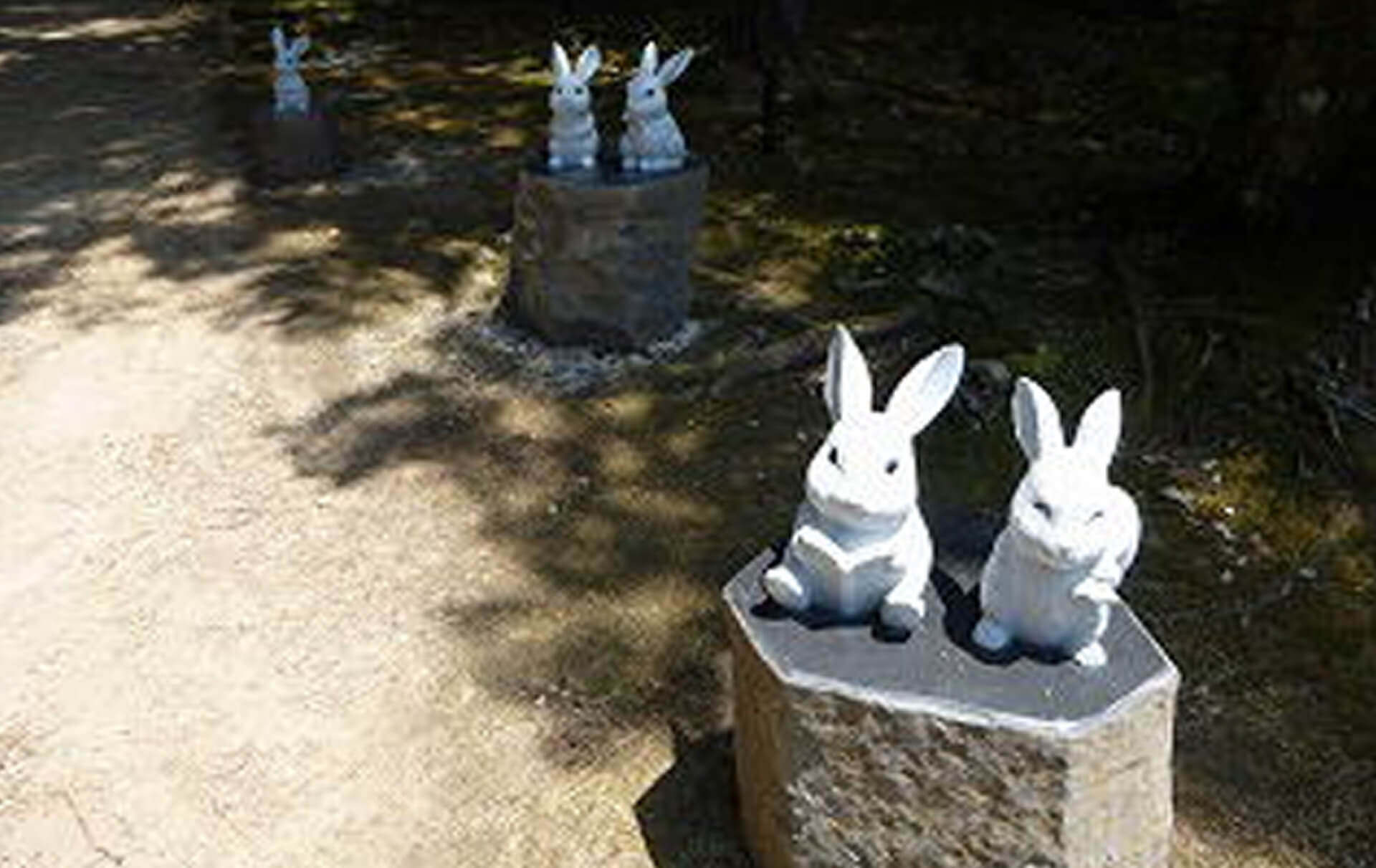
Many visitors are surprised by the numerous rabbit statues found within Izumo Taisha. While it is common to see fox statues at other shrines, rabbits are rarely seen outside of Izumo Taisha. So why is this the case?
This is due to the legend of the White Rabbit of Inaba (Inaba no Shirousagi), which is associated with Okuninushi-no-Okami, the deity enshrined at Izumo Taisha. For those who are not familiar with the story, here is a brief introduction to the legend of the White Rabbit of Inaba.
The White Rabbit of Inaba
Long ago, in the land of Izumo, there was a kind-hearted deity known as Okuninushi-no-Okami. He had many brothers, but among them, Okuninushi was particularly compassionate. One day, they heard rumors of a beautiful princess named Yagami-hime living in the land of Inaba and decided to visit her. Okuninushi followed behind his brothers, carrying a large bag and acting like their servant.
On their way to Inaba, at Cape Keta, the brothers encountered a white rabbit who had been skinned and was crying. The brothers cruelly deceived the rabbit, telling it to bathe in seawater and dry itself in the wind. Believing their words, the rabbit jumped into the sea and let the wind blow over it, which only worsened its wounds.
However, Okuninushi, who was following behind, spoke to the injured and suffering rabbit and listened to its story. The rabbit explained that it had tried to cross from the island of Oki to Inaba by tricking sharks, but was caught and skinned as a punishment. Okuninushi advised the rabbit to wash its body in fresh water and rest on a bed of cattail flowers. The rabbit followed his advice, and soon its beautiful white fur grew back, returning it to its original form.
When Okuninushi arrived in Inaba, many of his brothers proposed to Yagami-hime, but in the end, it was Okuninushi who was chosen by the princess. This story illustrates Okuninushi-no-Okami’s kindness and compassionate heart, symbolizing the divine qualities for which he is revered at Izumo Taisha.
To pass down the gentle spirit of Okuninushi-no-Okami to future generations, numerous rabbit statues have been created at Izumo Taisha.
To convey the kind-heartedness of Okuninushi-no-Okami to future generations, many rabbit statues have been created at Izumo Taisha.
(Image Citation: 出雲大社公式HP)
The Orientation of Shimenawa
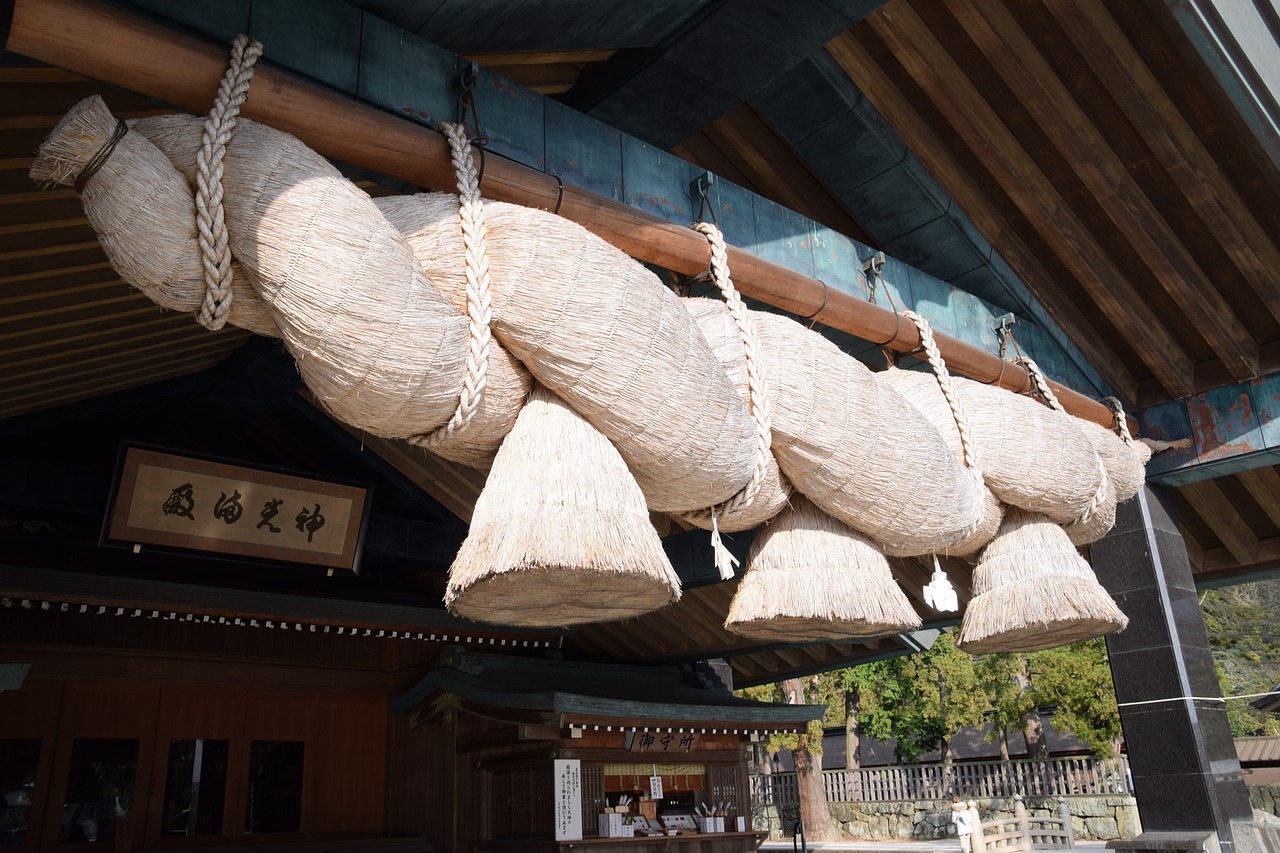
At Izumo Taisha, the shimenawa (sacred rope) plays a crucial role as a barrier that separates the sacred realm from the human world. These shimenawa are installed at two locations: the Worship Hall (Haiden) and the Kagura Hall (Kaguraden), with the one at the Kagura Hall being especially famous.
The shimenawa at Izumo Taisha are unique compared to those found at other shrines. Typically, shimenawa are twisted with the right side considered superior and the left side inferior. This means they are twisted starting from the right side and ending on the left when facing the deity. However, Izumo Taisha follows a different ancient custom where the left side is considered superior and the right side inferior. As a result, the shimenawa at Izumo Taisha are twisted in the opposite direction, starting from the left and ending on the right.
This distinctive arrangement reflects the positioning of the deities at Izumo Taisha. Within the main shrine, five deities are enshrined, with Ame-no-Minakanushi-no-Kami positioned on the far left, indicating the superior status of the left side. Records from the Edo period also note the practice of offering superior items on the left and inferior items on the right, confirming the unique tradition of "left superior" at Izumo Taisha.
Can the Emperor Enter Izumo Taisha?
Izumo Taisha enshrines Okuninushi-no-Mikoto, the deity of nation-building, with the hereditary priesthood traditionally held by the Izumo Kokuzo family, descendants of Amenohohi-no-Mikoto. Amenohohi-no-Mikoto is considered a child of Amaterasu Omikami in Japanese mythology, and the Izumo Kokuzo family is believed to be his direct descendants.
Due to this special lineage, only the Izumo Kokuzo family conducts the shrine's rituals. This tradition has been passed down through the ages, preventing outsiders, including the Emperor, from directly participating in the shrine's rituals.
Summary
How was it? This time, we introduced the history, highlights, and trivia of Izumo Taisha. It's surprising to learn that the shrine was originally built due to the Kuniyuzuri myth and was called Kizuki Taisha until the Meiji era. It's also interesting that the many rabbit statues around the shrine grounds are based on the legend of the White Rabbit of Inaba. The sheer number of rabbit statues is astonishing! Knowing these historical facts and trivia beforehand will allow you to enjoy Izumo Taisha from a different perspective. If you're interested, please visit Izumo Taisha!
Our website also introduces various aspects of Japanese history and culture beyond Izumo Taisha. If you're interested, we would be delighted if you read our other articles as well!



